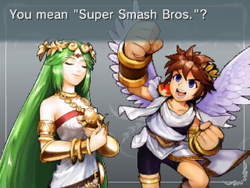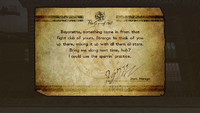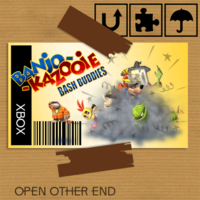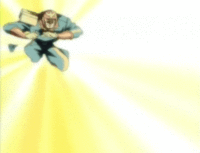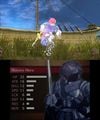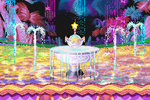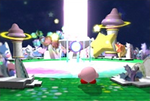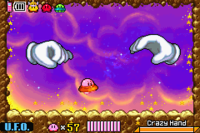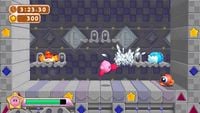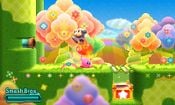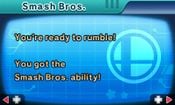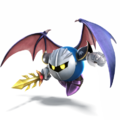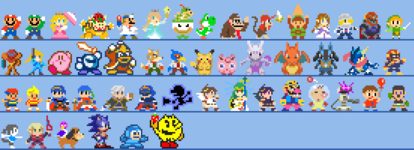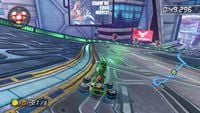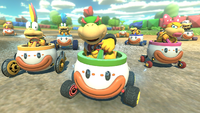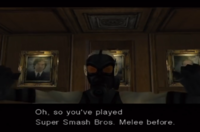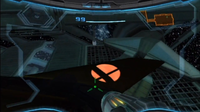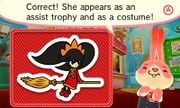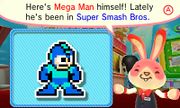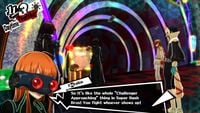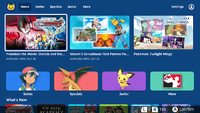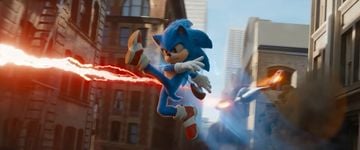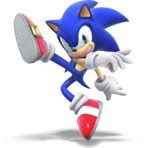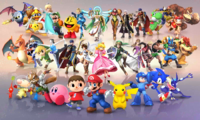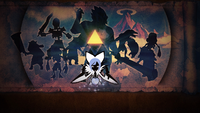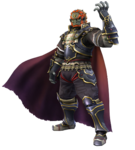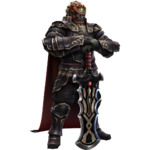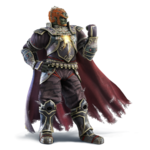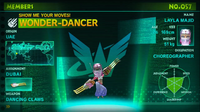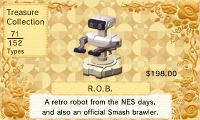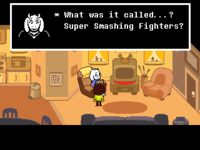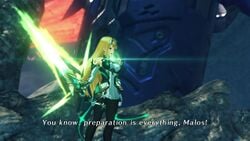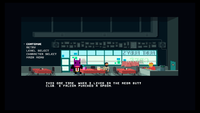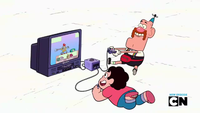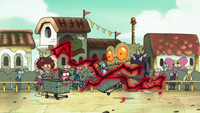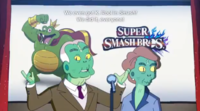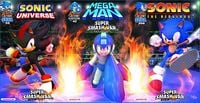List of Super Smash Bros. references in other franchises
As the Super Smash Bros. series is a crossover of numerous existing Nintendo properties, some of the properties represented have since made references to the series in their "native" media. Also, as the series is a cultural phenomenon in its own right, otherwise unrelated media have also made minor to major references to it over the years. This is a list of all known references to Super Smash Bros. outside of the series itself. This list only includes direct references to the series itself and lifted content that originates from the series, as opening the list to indirect references with multiple degrees of separation or simple coincidences will make it bloated and far too long.
Represented franchises[edit]
These are references from franchises directly represented in Smash.
General[edit]
- Arguably, any game with support from the Super Smash Bros. line of amiibo references Smash to some degree due to its roster affecting the availability of a character as an amiibo. This is especially true for those with specific functions only available from Smash amiibo. For instance, some amiibo-based Yoshi designs in Yoshi's Woolly World, such as those based on characters like Shulk or Sonic the Hedgehog, are only available through usage of their Smash amiibo. A full list of games compatible with Smash amiibo can be found here.
Animal Crossing[edit]
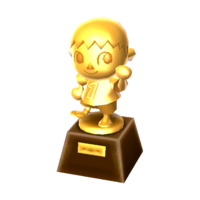
- In Animal Crossing: New Leaf, the player can win prizes by redeeming fortunes they receive from a fortune cookie. These prizes are items and clothing from other Nintendo games, and if the player wins the Blue Falcon furniture item, the fortune reads "When all else fails, never forget to show them your moves." in reference to Captain Falcon's famous taunt in the Super Smash Bros. series.
- Animal Crossing games released after SSB4 feature compatibility with the Villager amiibo. In Animal Crossing: amiibo Festival, a golden statue of the Villager's SSB4 design and pose is added to the plaza. In Animal Crossing: Happy Home Designer and the Animal Crossing: New Leaf - Welcome amiibo update, the player gains access to the same statue, called the "villager statue", for use in designing rooms. In Animal Crossing: New Horizons, the player is able to order a poster of the male player character, using his artwork from Animal Crossing: City Folk.
Bayonetta[edit]
- In the Nintendo Switch port of Bayonetta 2, scanning amiibo give special messages from Rodin to Bayonetta. While Peach, Daisy, Samus, Fox, and Link amiibo are specific to the character (as they unlock the outfits previously featured in the Wii U version), other amiibo provide generic messages. One message in particular, provided by any other Super Smash Bros. series amiibo, has Rodin mention a gift coming in from "that fight club of [hers]", and remarks how it is "strange to think of [her] up there, mixing it up with all them all-stars." Rodin also asks Bayonetta to "bring [him] along next time"; indeed, Rodin would go on to appear in Ultimate as an Assist Trophy.
Banjo-Kazooie[edit]
- In the ending for Banjo-Kazooie: Nuts & Bolts, when Gruntilda is shown working in the Lord of Games' ("L.O.G." for short) Videogame Factory as punishment for losing against Banjo & Kazooie, several packages can be seen in the background pertaining to fictional games that parody existing titles, such as "Cake Filler Instinct" (a reference to Rare's Killer Instinct series), and "Viva Piñata Kart" (a reference to the Mario Kart series as well as Rare's Viva Piñata series). One of these games is "Banjo-Kazooie Bash Buddies," a nod to the Smash Bros. franchise, though it predates Banjo & Kaoozie's inclusion in Ultimate by eleven years.
Chibi-Robo![edit]
- In Chibi-Robo! Zip Lash, figurines can be unlocked of Chibi-Robo in various poses. By scanning amiibo, one can unlock figurines of Chibi-Robo imitating a pose of that character's, in almost every case a pose from official artwork of the character. While some characters' poses resemble official artwork from their home series (the Pit pose, for example, matching his Uprising artwork), many resemble their appearances in Super Smash Bros. specifically:[1]
- The Mii Brawler, Mii Swordfighter, and Mii Gunner are original to SSB4 to begin with, and their poses match their SSB4 official art, and by extension, their amiibo.
- The Bowser Jr., Diddy Kong, Zelda, Ganondorf, King Dedede, Ike, Robin, Dark Pit, and Duck Hunt poses match their SSB4 official art, and by extension, their amiibo.
- The Sheik, Meta Knight, and Mr. Game & Watch poses match their Brawl official art (Mr. Game & Watch's being the same as in Melee).
- The Captain Falcon pose matches his dash animation from the Smash games.
- The Palutena pose matches her Heavenly Light animation from SSB4.
Cuphead[edit]
- In Cuphead, the DLC-exclusive playable character Ms. Chalice has a double jump that closely resembles the double jumps of most Smash Bros. fighters, emitting a large golden circle beneath her while she quickly spins forwards in the air.
Dillon's Rolling Western[edit]


Concept art of Dillon for Dillon's Dead-Heat Breakers. (right)
- In Dillon's Dead-Heat Breakers, the player can unlock and view concept art by earning stars from replaying a stage. One piece of concept art is of Dillon striking an identical pose to that of his trophy in Super Smash Bros. 4 (likely used as reference for designing his new costume).
Donkey Kong[edit]
- The Melee arrangement of the DK Rap is an available track in all regional releases of Donkey Konga. The opening theme to Melee, the Melee arrangement of Rainbow Cruise, and the Melee arrangement of Jungle Japes are also available tracks in the PAL release.
- The Melee arrangement of Jungle Japes returns in the Japanese release of Donkey Konga 2. The Melee arrangement of Green Greens, the Melee arrangement of the Pokémon main theme, the Melee arrangement of Mute City, and the Melee arrangement of the Super Mario Bros. 3 theme are available tracks in the PAL release.
- The opening theme for Melee also appears in the Japan-only Donkey Konga 3: Tabehōdai! Haru Mogitate 50 Kyoku.
- The ending of Donkey Kong Country Returns when playing as either Donkey Kong by himself or Donkey Kong with Diddy Kong has him perform a Giant Punch to ricochet off the moon in order to destroy the Tikis.
- Donkey Kong Bananza:
- One of Donkey Kong's unlockable skills, the Spin Jump, greatly resembles the Spinning Kong.
- In the bonus area, "Nostalgia Country", the television seen in Donkey Kong's tree house is based on the version seen in the trailers for King K. Rool and Banjo & Kazooie, rather than the designs in Donkey Kong Country or Donkey Kong Country Returns.
- One of Diddy Kong's animations has him make the pose from his Brawl artwork.
- In his introduction in the game King K. Rool slaps his belly in an extremely similar way to his side taunt.
- King K. Rool's design seems to be heavily based on the design in Super Smash Bros. Ultimate, with more realistic scales and a tattered cape, as well as the same combination of pre- and post-Rare design references.
- K. Rool's primary attack in the second phase has him use his Propellorpack to ram his body into the banana tower, resembling a mid-air version of his frantic, all-fours dash animation from Ultimate.
- One of King K. Rool's attacks during both of his main battles, uses an upgraded version of his Blunderbuss to suck Donkey Kong and Pauline inside of it and shoot them out, similar to how the Blunderbuss move works in Ultimate.
- DK Island's appearance in the DLC greatly resembles its appearance in K. Rool's Final Smash. This includes the mountains (where there is one rocky mountain instead of two snowy ones) and the placement of the treehouse being on the DK face's side instead of the front (albeit replaced with the Returns treehouse instead of the Country treehouse).
Dragon Quest[edit]
- On November 24, 2019, a special battle card was released for the arcade game Dragon Quest: Scan Battlers titled "Ultimate Gigaslash". It references Hero's Final Smash, Gigaslash, as well as their Ultimate reveal trailer, Heroic Encounter.[2]
- Heroes who were given a voice for the first time in the Super Smash Bros. series rather than the Dragon Quest series had their actors reprise their roles in the latter franchise:
- Nobuyuki Hiyama, Erdrick's Japanese voice actor, in Dragon Quest Rivals Ace[3][4] and Dragon Quest III HD-2D Remake.[5]
- Takeshi Kusao, Solo's Japanese voice actor, in Dragon Quest Monsters: The Dark Prince.[6]
EarthBound[edit]
- In Mother 3, the move PK Flash was recolored green; this trait first appeared in Super Smash Bros. Melee where Ness's neutral special, PK Flash, was also green. In EarthBound, all forms were instead colored white or yellow.
F-Zero[edit]
- Captain Falcon used his Smash Bros.-originated Falcon Punch ability in the F-Zero: GP Legend anime, as seen in his final showdown against Black Shadow. Unlike the Super Smash Bros. series, though, the punch generates blue visual effects of no particular shape or element.
- While not performed in-game, the Falcon Punch was also referenced in a line from the credits music of F-Zero GX.
- Captain Falcon's pose in his artwork for F-Zero GX is similar to his taunt in Melee.
- In that same game, when the player confirms their machine settings (picking between acceleration, max speed, or a mix of the two), Captain Falcon salutes the screen, also similar to his taunt.
Final Fantasy[edit]
- As part of the Digital Deluxe version of Theatrhythm Final Bar Line, the Ultimate remixes of Cosmo Canyon and Aerith's Theme are playable tracks. Rather than naming Super Smash Bros. Ultimate specifically, the songs list the origin as "COLLABORATION TITLE". Several details within the tracks reference the Super Smash Bros. series:
- The album covers for both "Cosmo Canyon -Collab Arrangement-" and "Aerith's Theme -Collab Arrangement-" respectively have Red XIII and Aerith Gainsborough with aura reminiscent of that of Spirits, alluding to their role as such in Ultimate.
- The borders for said album covers, featuring red and blue, are reminiscent of the color scheme to Super Smash Bros. 4, which had introduced Final Fantasy content in the Super Smash Bros series.
- The version of the Northern Cave is based partially on its appearance in Ultimate as a stage, descending into the planet's crater and into its core, ending with a fade to white.
- The background to "Cosmo Canyon -Collab Arrangement-"'s album cover is nearly identical to that of Cloud's splash art in Smash 4.
- The album covers for both "Cosmo Canyon -Collab Arrangement-" and "Aerith's Theme -Collab Arrangement-" respectively have Red XIII and Aerith Gainsborough with aura reminiscent of that of Spirits, alluding to their role as such in Ultimate.
Fire Emblem[edit]
- A pack of downloadable missions in Fire Emblem Awakening is entitled Smash Brethren, and pits Chrom in battles with two of Fire Emblem's three Smash Bros. fighters at the time, Roy and Ike. The third - Marth - is absent in this pack, although he makes appearances in other downloadable missions, and his character is an important aspect of Awakening's mythos, with many characters referencing the character's backstory and personality and Lucina going under his name to hide her identity.
- The four playable Fire Emblem characters from the base release of SSB4 are available in Fire Emblem Fates as recruitable units by scanning their amiibo. In Fates, there are some references to their Smash appearances, such as Robin's signature weapon being a Thoron tome[7]; while said tome was one of many weapons Robin could equip in Awakening, it is prominently used by him in Smash. The characters' dialogue also reflects their experiences in Smash in the context of fighting opponents from around the world.[8] Robin, in particular, makes mention of "launching the other fighters" and being launched himself.[9]
- In the card game Fire Emblem Cipher, elements of Roy's SSB4 appearance are used to give him unique outfits as a promoted Great Lord. The starter-deck card "S07-001ST: Young Lion, Roy" features his SSB4 headband and leg armor which resembles his SSB4 leg armor, and the two variant illustrations for the booster-pack card "B05-001SR: Heir of the Binding Flames, Roy" feature his SSB4 undershirt and belt.
- Fire Emblem Heroes features characters from across the Fire Emblem series with voice acting, often making effort to match voice actors with previous appearances. Roy and Lyn first received voice acting in Smash, and their respective Japanese voice actors (Jun Fukuyama as the voice of Roy, and Makiko Ohmoto as the voice of Lyn) are retained in Heroes. Ohmoto also voices Lyn in Fire Emblem Warriors. Recurring lines from the various characters in Smash are also quoted in Heroes:
- Marth's recurring taunt, "みんな、見ていてくれ!" ("Everyone, watch over me!"), is used in Japanese.
- Ray Chase debuts as Roy's English voice actor in this game. Additionally, one of Roy's recurring victory quotes, "守るべきもののために、負けられない!" ("For those I must protect, I cannot lose!"), appears.
- Roy's design in Smash, which took inspiration from both Binding Blade and DLC for Awakening, is used for the original version of Roy, with the only difference between his Smash and Heroes designs being that his cape is damaged in the former.
- In the English version, the special Choose Your Legends versions of Roy and Ike both make reference to their respective Smash crowd chants. When starting a battle with either of them in the player's party, Roy may say "Roy's our boy!", and Ike may confusedly say "You... like Ike?" These lines have no equivalent in the Japanese version.
- Lucina's Choose Your Legends version quotes one of her Smash victory lines when starting a battle with her in your party: "The future is not written!" This line also has no Japanese equivalent.
- In both versions, Lyn's Choose Your Legends version also quotes Smash when she activates special skills. One of her possible lines - "Prepare yourself!" - is also one of her possible lines when her Assist Trophy is summoned.
- During the sixth Brave Heroes event, Sothis makes a reference to Byleth's trailer in Brave Byleth's S-rank conversation during the associated Forging Bonds event.
- Fire Emblem Echoes: Shadows of Valentia features amiibo support for the Fire Emblem characters who have obtained amiibo through the Super Smash Bros. line, which can be scanned to summon illusory versions of the characters as allies. Since the characters use the designs depicted on the amiibo themselves, the depictions of Marth and Roy directly draw from their SSB4 designs even when these designs' details disagree with previous Fire Emblem games; examples include Marth's collar and Roy's entire outfit.
- Many of the Emblems in Fire Emblem Engage have direct references to their appearances in Smash.
- When a character with an emblem defeats an enemy, the character may quote a victory pose quote:
- Characters with Marth may say "I live to fight again" or "The day is mine".
- Characters with Roy may say "For those I must protect", "That was a fierce battle", or "Now the true battle begins".
- Characters with Ike may say "I fight for my friends" or "You'll get no sympathy from me".
- Characters with Corrin may say "That went well".
- When Roy is first summoned, he makes the same pose as his up taunt. Likewise, when Ike is first summoned, he makes the same pose as his artwork for Ultimate.
- In the English localizations, Ike and Corrin's Engage attacks are named after their Final Smashes, Great Aether and Torrential Roar. Characters engaged to the emblems may say "Don't stand in my way" or "Out of the way" respectively, being one of Ike's victory pose quotes and Male Corrin's Final Smash quote.
- When a character with an emblem defeats an enemy, the character may quote a victory pose quote:
- Playable characters in Fire Emblem Warriors generally have their official artwork posed to match the characters' official art from their source games. Both male and female versions of Robin appear as playable characters, but neither version had official artwork for their debut game of Fire Emblem Awakening; instead, they take their artwork poses from their respective SSB4 artwork, albeit with a different tome and without the Levin Sword.
- Marth and Celica's moveset takes inspiration from Marth's moveset in the Super Smash Bros. series. The basic string includes Marth's jab, up tilt, and dash attack, in that order. Their first strong attack when charged is the Dolphin Slash, their third strong attack is based on the neutral air, the fourth and fifth Strong attacks are based on the Dancing Blade, and the sixth strong attack ends with his up smash. Additionally, for Marth only, the final attack of the Awakening mode is the Shield Breaker.
- Robin's use of Elfire and Elwind is very similar to the use of Arcfire and Elwind in Smash 4. The use of Robin's Levin Sword in their special is very similar to his jab as well.
- Corrin is capable of sprouting wings out of their back in this game. This was an idea created for Smash 4.
Kid Icarus[edit]
- Pit and Palutena's appearances in Kid Icarus: Uprising are lifted directly from their designs in Super Smash Bros. Brawl. Pit's bifurcated bow from Brawl also appears in-game as the Bow-type weapon Palutena's Bow (in fact, all bow-type weapons can be split for melee attacks), and Dark Pit himself is based directly upon Pit's black palette swap from Brawl. In addition, multiple direct references are made to the Super Smash Bros. series in the game - Brawl itself in particular - as the game often breaks the fourth wall.
- In the English version, the instruction of tapping the Circle Pad to dash makes Pit remark that the technique feels familiar. Palutena claims the technique is akin to a game called "Super Bash Sisters", before Pit corrects her, explicitly name-dropping the series as seen above.
- The same conversation, in Japanese, has Palutena refer to the series as "Super Whatever Bros.", though Pit does not explicitly name-drop the series.
- When using a Bow-type weapon, a conversation will sometimes start up where Pit mentions using a bow "in the last brawl". Horrified, Palutena asks Pit if he was hurt, to which he denies, and comments on how "it was a smash". She claims she cannot imagine him "in a melee", to which Pit replies that he was not.
- In the English version, the instruction of tapping the Circle Pad to dash makes Pit remark that the technique feels familiar. Palutena claims the technique is akin to a game called "Super Bash Sisters", before Pit corrects her, explicitly name-dropping the series as seen above.
Kirby[edit]
- In Kirby 64: The Crystal Shards, when Kirby defeats a boss, he says "Hi", using the same voice clip that Super Smash Bros. used for Kirby's taunt one year prior. This was the first game in the Kirby series where Makiko Ohmoto voices Kirby, who first voiced him in the original Super Smash Bros.
- Elements of the visual design of the Fountain of Dreams stage in Melee were incorporated into its appearance in Kirby: Nightmare in Dream Land, and the design was used more fully in Kirby Super Star Ultra and Kirby Fighters Deluxe.
- The remixes of Kirby music tracks used on the Fountain of Dreams and Green Greens stages in Melee are featured in Kirby Air Ride as alternate tracks on the Nebula Belt and Fantasy Meadows tracks, respectively. The music for Green Greens is also used during the Robobot Armor section of Stage EX8 of Access Ark in Kirby: Planet Robobot. The music for the Fountain of Dreams stage in Melee was also reused in Kirby: Nightmare in Dream Land and Kirby: Triple Deluxe. The Kirby Air Ride remixes would also be used in the anime, Kirby: Right Back at Ya!, more specifically the Japanese version.
- Additionally in Air Ride, players can unlock and choose colors for Kirby, Meta Knight, and King Dedede, which is similar to the palette swaps from the Super Smash Bros. games. A lot of mechanics for the game are similar to Melee as well, such as a star count to let the player know how many times he's destroyed another player's machine, similar to how there is a star counter to tell a player how many KOs he or she has gotten. The sound effect heard when selecting a menu option is the same as the effect used in Melee but pitch shifted down.
- In Kirby & The Amazing Mirror, both Master Hand and Crazy Hand make appearances as the bosses of the Candy Constellation area. Inhaling either of them will grant Kirby the Smash copy ability, which allows Kirby to perform select moves from his moveset from the Super Smash Bros. series, mostly based on preexisting abilities: Vulcan Jab (representing his neutral attack), Hammer, Final Cutter, Stone, and Twinkle Star (representing his neutral aerial, being the only unique move in this ability). This move can also be obtained randomly by swallowing multiple enemies at once. Visually, Kirby is identical to his default non-ability appearance, as it is how he normally appears in Smash Bros.
- The Smash ability returns in the Kirby's Dream Collection anniversary compilation, in two of the game's original Challenge Stages using the engine from Kirby's Return to Dream Land. These two stages are based entirely around navigation and combat with the ability, which is the only one available. In the first of these two challenges, the music that plays can either be the Drag Race theme from Kirby Air Ride or "City Trial: City (Backside)" from the same game; these songs bear many similarities to Super Smash Bros. Melee's Battlefield theme and menu themes, respectively. The Super Smash Bros. logo can be seen on the background tiles of the stages. Smash Kirby also obtains a chargeable flying kick called Smash Kick, referencing his forward smash, which in turn is a reference to the original Spin Kick used in Kirby Super Star.
- In Kirby: Planet Robobot, Kirby can obtain the ability (now named "Smash Bros.") by scanning the Kirby amiibo from the Super Smash Bros. line or finding hidden Copy Essences. The ability now has the Ninja ability's Air Drop technique, referencing Kirby's up throw; the grounded variant of Hammer has been reworked to resemble Hammer Flip from Smash 4 onward, with ability to charge for more damage, as well as being able to move and jump while doing so; Smash Kick can also be charged, further resembling his forward smash. Its guard also produces a red shield as a visual effect exclusive to the ability.
- On a side note, the Smash Bros. ability still has Hammer's aerial variant from Melee in both Kirby's Dream Collection and Kirby: Planet Robobot, despite Kirby no longer using it in Smash proper since Brawl.
- In Kirby: Squeak Squad, the Uja enemy is a swarm of black particles that takes a form closely resembling Master Hand, similarly to Master Core.
- Fighter Kirby's Aerial Spin Kick move in The Amazing Mirror is similar to his forward aerial in the Super Smash Bros. games.
- Kirby Super Star Ultra:
- This game names one of Meta Knight's techniques Mach Tornado, with him transforming into a similar yellow cyclone before becoming an enormous tornado.
- The model of the Halberd used in the cutscenes of Revenge of Meta Knight is the one from Brawl.
- A crystalline version of Wham Bam Rock called Wham Bam Jewel appears, with some new additional moves, likely inspired by Master Hand's moves.
- Cook Kirby's pot has utensils added to the front, similar to his Final Smash in Brawl.
- In Kirby Mass Attack, the Superspicy Curry appears as its Brawl design.
- Kirby's Return to Dream Land:
- This game adds the Hammer Twirl technique to the Hammer ability, which resembles King Dedede's down aerial from Brawl.
- Meta Knight's own moveset also include a modified sword attack similar to his neutral attack, as well as Shuttle Loop, which is based off of his recovery move instead of Kirby's variant, sending him forward in a controllable glide.
- If the player attempts to delete a save file, three warning pop-ups show up instead of two from the previous games, similar to Brawl's Erase Data feature.
- Kirby: Triple Deluxe includes a bonus game called Kirby Fighters, which is based heavily on the Super Smash Bros. series, including various mechanics such as air-dodging, shielding that results in stun if overused, perfect shielding, and rolls. Kirby Fighters Deluxe, the eShop-exclusive sequel, adds teams and features an army of King Dededes as the final boss, similar to the Multi-Man Smash mode. Shadow Dedede has an attack similar to Dedede's up special. Master Hand is a keychain in this game. A remix of the music that plays on the Fountain of Dreams stage in Super Smash Bros. Melee is featured, which plays during the Hypernova section of the second extra stage of Royal Road.
- The figurines in Kirby and the Rainbow Curse behave very similar to the trophies.
- Kirby: Planet Robobot:
- Meta Knight's design has received minor changes that resemble his appearances in Brawl and SSB4, more so than in previous Kirby games, including having his logo on his pauldron and differently designed shoes. He also obtains a new move called Galaxia Darkness, where he covers himself with his cape, turns the screen dark, and slashes horizontally to his sides, identical to his Final Smash. His jumping spinning move is also called Mach Tornado, though in name only.
- Master Hand also makes a cameo appearance as a sticker, using stock art from his appearance in Kirby & The Amazing Mirror, as well as a golden statue holding the Smash logo for Smash Bros. Kirby's Stone attack.
- Scanning Smash 4-series amiibo gives Kirby copy abilities similar to the scanned character, with some of them being directly based on their depictions in Smash; for example, Ganondorf gives the Poison ability, which resembles the darkness effect of his attacks, while Mr. Game & Watch gives the Circus ability, with the ability's juggling attack referencing Mr. Game & Watch's throws.
- Doctor and ESP, two of the abilities introduced in this game, give Kirby hats that resemble Dr. Mario and Ness respectively, complete with attacks similar to the usage of Megavitamins and PK Flash in Smash; appropriately, these abilities can be obtained by scanning their amiibo.
- One of Meta Knight's attacks in Kirby Battle Royale is very similar to his down special move, Dimensional Cape.
- Kirby Star Allies:
- Completing a save file to 100% results in there being about a 50% chance to play the Kirby Air Ride arrangement of Green Greens, which is closely based on Melee's Green Greens arrangement, in the file's main menu.
- King Dedede, in his playable appearance, can use the Super Dedede Jump following the 4.0.0 update, while Parallel Dedede utilizes Gordo Throw during his first phase. Meta Knight, as of the 4.0.0 update, can also use Galactic Counter, which works identically to the many counterattacks in Smash Bros.
- The pose Magolor makes in the pause screen is identical to his trophy in Super Smash Bros. for Wii U.
- The Ultimate Choice mode in this game uses a difficulty system similar to the Intensity mechanic in Smash 4 and Ultimate's Classic Mode, in which higher difficulties raise the amount of rounds, and decrease the amount of healing items and the player's HP, but reward more Picture Pieces.
- In Kirby Fighters 2, King Dedede can use Gordo Throw as one of his attacks as a boss, while playable Dedede gets an entrance pose based on his Ultimate artwork. The Wrestler ability was introduced in this game and is inspired by Incineroar's moveset.
- In Kirby and the Forgotten Land, after King Dedede is saved, he can be seen in Waddle Dee town relaxing in his Super Smash Bros. crouching pose.
- Kirby's Dream Buffet:
- This game features a pair of white gloves known as the Server Hands who greatly resemble Master Hand and Crazy Hand. When starting a race, one of the Server Hands will recreate the countdown that Master Hand does in the opening movie for Smash 64.
- The names for the first four alternate colors for Kirby are taken from Smash 64's Japanese website: Keeby Yellow, Ice Blue, Tea Green (Kusamochi Green in Japan), and Fire Red.
- When a player is hit by an opponent under the effects of invincibility candy, they will fly into the screen in a manner similar to a Screen KO.
- Master Hand and Crazy Hand both appear as collectable Character Treats, the former appearing as a sprite and the latter using stock art, both from Kirby & The Amazing Mirror.
- Kirby Air Riders:
- Meta Knight's render pose slightly resembles his pose in his Ultimate render.
- The splash screens when new characters were revealed during the Kirby Air Riders Directs on August 19, 2025 and October 23, 2025 resemble the splash screens from Super Smash Bros. 4 and Ultimate's newcomer reveal trailers.
- The colored backgrounds during a character's victory screen resembles the ones from Ultimate's victory poses.
- The background when dealing a hit that destroys an opponent's machine resembles that during a Finish Zoom.
- The visual effect when a character eats food resembles the one in Ultimate.
- Several alternate costumes from Smash 4 and Ultimate appear in this game, including all of Kirby's (sans his orange and Meta Knight-inspired costumes) King Dedede's pink, cyan, and blue costumes, and Meta Knight's Galacta Knight and Dark Meta Knight-inspired costumes.
- The character icons in this game have a similar art style to Ultimate's stock icons (albeit circle-shaped instead of the shape of the character's head), and Kirby and Meta Knight's bear a striking resemblance to their stock icons from Ultimate.
- Several sound effects, most noticeably the hit sound effects for direct hits as well as fire and slashing-based attacks, are recycled from Ultimate.
- The Figure Player functionality for amiibo works similarly to Smash 4 and Ultimate's.
- The Global Win Power mechanics works similarly to Smash 4 and Ultimate's Global Smash Power, though it is solely based on the number of wins rather than percentage.
- Sandbag makes an appearance in the City Trial and Road Trip modes of the game.
- Brawl's arrangements of King Dedede's Theme, The Legendary Air Ride Machine, and Meta Knight's Revenge, as well as Ultimate's arrangement of City Trial, are featured in the game.
- Near the end of the second Direct, Sakurai announces that the game will not have any DLC while saying "Everything is here!", which may be a reference to the "Everyone is here!" tagline used for Ultimate.
Mario[edit]
- Luigi is first seen using fireballs without the Fire Flower in Smash, which would be carried over into several spinoffs. His green fireballs were also first used by him in Smash; they previously debuted as obstacles in Mario Bros.
- While arguably not explicitly references, several special moves invented for Melee have gone on to become used in Mario games:
- Before Melee, Bowser had never used his shell as a weapon like other Koopas (save for the third-party educational game Mario's Time Machine). With the introduction of the Whirling Fortress, shell maneuvers are now a common part of Bowser's arsenal, seeing use in Mario Kart: Double Dash!! as items, as well as in Mario Power Tennis, Super Mario Galaxy 2, Mario & Luigi: Bowser's Inside Story, and New Super Mario Bros. U.
- In Mario Sports Mix, several of Luigi’s moves involve him performing an attack similar to his dash attack and even a move that largely resembles the Green Missile.
- In the Spanish translation of Paper Mario: The Thousand-Year Door, one of Rawk Hawk's lines telling weaklings to "stick to video-game fighting" has been changed to "stay home playing Super Smash Bros. Melee". In the Nintendo Switch remake, he only says "Super Smash Bros." without specifying Melee.[10]
- When Peach wins a minigame in Mario Party 6 and Mario Party 7, her quote is a slightly taunting, "Oh, did I win?", a quote taken directly from one of her victory screens from Melee onward. This quote is reused in several Mario & Sonic at the Olympic Games titles.
- Two of the Mystery House stages in Super Mario 3D World have the goal of defeating every enemy to advance; their English titles are Mystery House Melee and Mystery House Brawl.
- The Mario Kart 8 DLC pack The Legend of Zelda x Mario Kart 8 contains Mute City, a course based on the F-Zero series. A screen in said course depicts Captain Falcon alongside the quote "Show me your moves!", a line originating from his taunt in the Smash series.
- In Mario Kart 8 Deluxe, the Koopa Clown kart body from Mario Kart 7 (based on the Koopa Clown Car) returns; when used by the Koopalings, its color scheme changes to match the ones used by the variations on the Junior Clown Car they use in SSB4 and Ultimate.
- Super Mario Maker has 50 Costume Mario options unlocked by scanning Smash amiibo (although they can also be unlocked other ways); some of these depictions make references specific to their Smash Bros. incarnations. These include details such as R.O.B. firing boosters from his base, which was introduced in Brawl; the usage of Duck Hunt, with the duck riding on the dog's back, as a single character, a combination introduced in SSB4; and Zero Suit Samus with jet boots, introduced in SSB4. Squirtle and the Ice Climbers also appear as downloadable costumes, although their appearance in Super Mario Maker is unconnected to Smash.
- In Mario & Luigi: Paper Jam, the final mission for Neo Bowser Castle is named after the Final Smash move from the Super Smash Bros. series. Additionally, the game refers the paper versions of the characters via the title "Paper" in front of their names, much like the trophies of them from Melee to SSB4 (the Paper Mario series RPG games proper, however, treats the paper versions of the characters and their normal selves as being one and the same).
- Iggy Koopa's trophy description in the Japanese version of SSB4 states that he uses ボクチャン as his first-person pronoun and stylizes his laughter (which was first established in New Super Mario Bros. Wii, which the Koopalings' voice clips in Smash are mostly sourced from) as アハハハハ☆; likewise, Ludwig von Koopa's description states that he uses ワタシ as his first-person pronoun, something that weren't established in their home series at time due to the Koopalings lacking any spoken dialogue; all of those were eventually carried over when the Koopalings were given an extensive amount of dialogue in the Mario & Luigi series starting with Mario & Luigi: Paper Jam as well as in Paper Mario: Color Splash.
- Mario Tennis Aces added Fire Piranha Plant as a playable character in a free DLC in June 2019. The character's inclusion in that game might have been influenced by the depiction of Piranha Plant in Ultimate as it not only marks the first playable appearance of the species in the Mario series (outside of Petey Piranha), but the two plants also share several Smash traits such as moving around in a pot and their crouching animation.
- Super Mario Maker 2
- The new sky level theme for the Super Mario Bros. style is partially based off of the Mushroomy Kingdom stage's default theme.
- The downward thrust of the Link power-up causes the player to stall-then-fall like Toon Link's variant of the attack instead of being a simple downward sword thrust like its original Zelda II: The Adventure of Link appearance.
- Dr. Roy's artwork in Dr. Mario World is based on his Ultimate artwork.
- The Super Mario Bros. Movie
- Mario is seen performing an overhand punch in midair, similarly to his forward aerial from Melee onwards, during a fight with Donkey Kong and against a cardboard Bowser during a training montage. Mario and Luigi do the same attack against the real Bowser at the end of the film, sending Bowser plummeting straight downwards similarly to its meteor smash properties in Smash.
- The fight with Donkey Kong is in a floating arena with items scattered throughout, similarly to Smash.
- The climax features a Banzai Bill (called a Bomber Bill) being fired at Peach's castle, much like the stage hazard on the Melee stage of the same name. The idea of Banzai Bill being explosive also originates from Melee.
- In Super Mario Bros. Wonder, Yellow Yoshi's render resembles his official render in Super Smash Bros. 4.
Metal Gear[edit]
- In Metal Gear Solid: The Twin Snakes, the enhanced GameCube port of Metal Gear Solid, a character and boss in the game, Psycho Mantis, claims to have the ability to read minds. In addition to detecting the player's inputs and forcibly rumbling the player's controller, he will also comment on save data found in the same memory card; Psycho Mantis has unique dialogue if Melee's save data is detected. Notably, this reference was made before Metal Gear was actually represented in Smash Bros., although Snake was considered for Melee.
- The Brawl remix MGS4 ~Theme of Love~ Smash Bros. Brawl Version appears as a track in Metal Gear Solid 4: Guns of the Patriots on Snake's in-game iPod, under the title "Love Theme (Action Version)".
Metroid[edit]
- In Metroid Prime 3: Corruption, bumper stickers can appear on Samus's Gunship depending on save data on the same Wii. If save data from Brawl is present, a sticker of the Super Smash Bros. logo can appear.
- In Metroid: Other M, Ridley can replicate his wall scraping attack from a cutscene in The Subspace Emissary.
- The Paralyzer and Zero Suit were simply known as a "rather useless emergency pistol" and a "body suit" respectively in their debut in Metroid: Zero Mission. However, in Other M, they take on the "Paralyzer" and "Zero Suit" names from Brawl.
- Obtaining the "best" ending in Fusion Mode in Metroid: Samus Returns causes Samus to appear in her blue Casual Outfit from Metroid Fusion. Because Samus has a ponytail and her bangs from Other M (both of which are present in Zero Suit Samus' SSB4 design and were absent in Fusion), she superficially resembles one of Zero Suit Samus' alternate costumes from that game.
- In Metroid Dread, Kraid is battled in a room where he is partially submerged in lava. Since Kraid was never associated with lava in earlier Metroid games, this appears to be a reference to his appearance in Brinstar Depths from Melee.
- In Metroid Dread, the Hyper Beam is depicted as a very large, continuous laser blast. The game's internal files refer to the Hyper Beam as "zerolaser", implying that its appearance is directly inspired by the Zero Laser Final Smash.
Mii[edit]
- In Nintendo Land, the Metroid Blast attraction features the Smash-original "Green Samus" costume as one of the multiplayer colors. Similarly, another multiplayer color resembles the Fusion Suit, much like one of Samus's alternate costumes.
- In Nintendo Land, the Kraid animatronic emerges from a pool of lava and remains partially submerged throughout the entire battle. Since Kraid was never associated with lava in earlier Metroid games, this appears to be a reference to his appearance in Brinstar Depths from Melee.
- In Miitopia's Switch port, Boss Battle Time I's name is now changed simply to Boss Battle, its stage name in Ultimate.
Nintendo Badge Arcade[edit]
- The Arcade Bunny, host of the Nintendo 3DS application Nintendo Badge Arcade, sometimes references characters' appearances in Smash as part of introducing new badges.
- In discussing various crossover appearances of Mr. Resetti, he makes mention of his appearance as an Assist Trophy in Brawl.
- Pikachu and Greninja badges were pointed out specifically as characters who had appeared in Smash.
- Ashley was mentioned as having appeared in Super Smash Bros. for Wii U both as an Assist Trophy and as a costume (for Mii Swordfighters).
- Mega Man's appearance in Smash was referenced in as a more recent appearance of the character.
No More Heroes[edit]
- In No More Heroes III, the final boss battle against Damon Ricotello is done in the style of Super Smash Bros., being set on a flat stage in a 2D plane with percentage meters for both Travis and Ricotello.
Pac-Man[edit]
- Pac-Man's SSB4 artwork is used on Bandai Namco's official site.
Persona[edit]
- In Persona 5, Futaba Sakura comments on the Battle Arena in Sae Niijima's Palace by comparing it to the "challenger approaching" mechanic from Super Smash Bros.. Coincidentally, two years after Persona 5 came out, Joker would be announced as a downloadable newcomer for Ultimate.
- In the Nintendo Switch version of Persona 5 Strikers, having Super Smash Bros. Ultimate save data unlocks the ability to select "Last Surprise" from Persona 5 and "Take Over" from Persona 5 Royal as the default battle music. Having save data for Strikers, likewise, unlocks the Sophia spirit in Ultimate.
- The "Beneath the Mask" remix in Ultimate would be performed during the PERSONA SUPER LIVE P-SOUND WISH 2022 concert as "Beneath the Mask (PSW2022 Special Remix)".[11]
Pikmin[edit]
- In The Night Juicer, one of the Pikmin Short Movies, a picture on Captain Olimar's bulletin board depicts his Brawl model standing in front of the Hocotate Ship.
- In Hey! Pikmin, the Winged Pikmin can carry Olimar into the air, similarly to his up special move in Smash 4 and Ultimate.
Pokémon[edit]
- An event distribution based on the Greninja that appears in Super Smash Bros. 4 was available for Japanese players to download to Pokémon Omega Ruby and Alpha Sapphire via serial code if they registered both that game and Super Smash Bros. for Nintendo 3DS with Club Nintendo during the end of 2014 into early 2015. The Greninja knows its four special moves from Smash, Water Shuriken, Shadow Sneak, Hydro Pump, and Substitute; it also has its rarer Hidden Ability, Protean. Its Original Trainer is named スマブラ (Sumabura), an abbreviation of Smash Bros.
- Greninja's ability to use blades out of water came from Smash 4, and would later be used in the anime, the Detective Pikachu film, and Pokémon Unite.
- In Pokkén Tournament, one of the dialogue options for the player's trainer is "Show me your moves!", in reference to Captain Falcon's recurring taunt in Smash.
- In Pokémon Sun and Moon, there is a scene where Professor Kukui says to Guzma, "Let's see it, Guzma! Show me your moves and prove you aren't just all talk!", making another reference to the taunt.
- Gardevoir's walking animation, unused but in the data of Sun and Moon before being used in many recent games from Sword and Shield onwards, is the same as its Poké Ball appearance in the Smash series.
- Pichu's Ultimate render was used for the Junior section of Pokémon TV's menu.
- Charizard's Ultimate render is referenced in the Pokémon anime's Master Class artwork.
- Mewtwo's Ultimate render is referenced with its "Martial Arts Style" Holowear from Pokemon Unite.
- The Jazwares Battle Figure Multipack 10 Pack exclusive to GameStop specifically contains all Pokémon that are playable in the Smash series: Pikachu, Jigglypuff, Pichu, Mewtwo, Squirtle, Ivysaur, Charizard, Lucario, Greninja, and Incineroar.
Sonic the Hedgehog[edit]
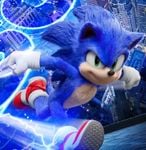
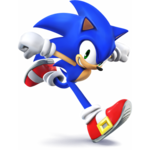
Right: Sonic's main character artwork from Smash 4.
- Each of Sonic's renders from the Super Smash Bros. series have been referenced in the Sonic the Hedgehog series.
- Sonic's Brawl render is referenced in Sonic and the Black Knight (appearing, albeit edited, as his character select icon in the game's multiplayer mode) and Mario & Sonic at the Olympic Winter Games (appearing as the pose for a Sonic snowman statue), along with Sonic Generations and Sonic Forces (appearing as Classic Sonic's finishing pose upon earning a B ranking in a level).
- In the 2020 film Sonic the Hedgehog, Sonic is seen making poses that are identical to his official artwork from Smash 4 and Ultimate. The most notable example is one scene where Sonic, being chased by Dr. Robotnik, performs a pose that has a striking resemblance to his official Super Smash Bros. Ultimate render, jumping and posing in similar anatomy. Another example is not in the movie, but rather one of the movie's promotional posters, where Sonic is running in a similar pose to the one seen in his Smash 4 artwork.
- The limited edition poster for the sequel, Sonic the Hedgehog 2, also features a mirrored silhouette of the pose in the top right corner, and the pose also briefly appears in the film's dance sequence.
- The Brawl remix of Angel Island Zone is featured in several Sonic media:
- It is the featured in the album True Blue: The Best of Sonic the Hedgehog under the name "Angel Island Zone ~SSBB Remix~". The album released on January 23rd, 2008, a week before Brawl's Japanese release, though an interview with Jun Senoue states it was created for Brawl.
- It is featured in various Mario & Sonic titles, as well as in Sonic at the Olympic Games; in this game, it is specifically acknowledged as a Brawl remix, being called "Angel Island Zone (SSBB Remix)".
- It is featured as an unlockable music track in Sonic Origins under the name "Angel Island Zone -SSBB RMX-".
- Sonic the Hedgehog Encylo-speed-ia contains a section detailing all Sonic content in the Super Smash Bros. series, including moveset, story mode roles, spirits, and trophies. It also notes that Sonic can not be unlocked in Cruel Melee, a reference to Electronic Gaming Monthly's Sonic and Tails hoax.
- In Sonic Racing: Crossworlds, one of Sonic's quotes in gameplay is "You're too slow!", his quote from his side taunt in Brawl.
- This line was additionally referenced in an episode of "Sonic Racing: CrossWorlds - CrossTalk", where either Sonic and Tails or Jet and Wave would discuss the characters leading up to the release of the game; in said episode, Sonic gave Tails' normal intro, which Tails points out, to which Sonic responds that Tails was "too slow".
- One of Joker's trick animations is his render from Ultimate.
Splatoon[edit]
- A Hero vs. Villain Splatfest was held in Splatoon 2 from December 15-16, 2018 to celebrate the release of Super Smash Bros. Ultimate. The accompanying panel image featured 14 fighters using their artwork from Ultimate, with Kirby, Samus, Link, Donkey Kong, Mario, Fox and Pit representing the Hero team and King Dedede, Ridley, Ganondorf, King K. Rool, Bowser, Wolf, and Dark Pit representing the Villain team. The Splatfest was announced on December 5, 2018 and took place from December 15 to December 16, with the Villain team ultimately winning.
Star Fox[edit]
- In Star Fox Zero, the designs for members of Team Star Fox, including Fox McCloud and Falco Lombardi, now include a small green reticle over their right eyes; this detail originates in Fox and Falco's Brawl and SSB4 designs, rather than previous Star Fox games. According to Star Fox Zero – The Battle Begins, the visor is Slippy Toad's most recent invention. Other elements, such as a Reflector-like device worn on the hip by Fox and Falco, also appear to be drawn from the Brawl-onward Smash design.
- Also in Star Fox Zero, during the Titania Landmaster mission, Falco will quote his line from Brawl and SSB4 when he uses his Final Smash: "Personally, I prefer the air."[12]
- In Starlink: Battle for Atlas, Fox and Falco's pilot intro cutscenes feature recreations of their victory poses that originated in Melee.
Street Fighter[edit]
- In Street Fighter V's main menu, the silhouette of Ryu's SSB4 official art is used in the Casual Match box.
StreetPass Mii Plaza[edit]
- A Puzzle Swap panel based on "Super Smash Bros. for Nintendo 3DS / Wii U" was released in Japan in December 2014, and in Western regions in February 2015. The completed image depicts the starting roster. Viewing it will display character silhouettes of the starter characters moving towards the screen.
The Legend of Zelda[edit]
- The Zelda spinoff title Hyrule Warriors contains several references to the Super Smash Bros. games:
- When using the Hylian Sword or Master Sword moveset, one of Link's combos involves using a Spin Attack while ascending off the ground; gaining aerial height with the Spin Attack is otherwise an attribute unique to its Smash Bros. appearances.
- As part of her Rapier moveset, Princess Zelda's Special Technique when Focus Spirit is active involves using Nayru's Love, Farore's Wind, and Din's Fire in rapid succession. These spells from The Legend of Zelda: Ocarina of Time were used by Link in their original appearance, with Super Smash Bros. Melee being the first game to give these spells to Zelda.
- One of Sheik's combos involves a spinning kick similar to her down smash in the Smash Bros. series, an action never previously seen in the Zelda series itself.
- Ganondorf's Ocarina of Time incarnation appears in a cutscene describing Cia's backstory wielding his sword from the SpaceWorld 2000 GameCube Tech Demo. The only game released prior to Hyrule Warriors in which Ganondorf was shown using this sword in any capacity was Melee, where it appeared in his official artwork, one of his victory poses and his All-Star trophy. Also, one of Ganondorf's combos when using the Great Swords involves him performing a punch that looks very similar to the Brawl version of his neutral special, Warlock Punch.
- The usage of the names Young Link for the child-age Link from Ocarina of Time and Majora's Mask and Toon Link for the Link from The Wind Waker are identical to how they are referred to in their Smash Bros. appearances, as opposed to their home games where they are simply known as "Link".
- One of Toon Link's special moves involves him swinging his sword in a panic, and pausing to catch his breath after the move, likely as a reference to his down taunt.
- For the Twilight Princess themed costumes for Link, Zelda, and Ganondorf, Ganondorf's costume is based off the variation of his Twilight Princess outfit from Brawl. It lacks the glowing stab wound on the chest, and the cape's hemline is neither torn or tattered.
- Zelda's Ocarina of Time-themed costume depicts her as wearing heels underneath her dress, much like her appearance in Melee, instead of boots like in the game proper.
- In Cadence of Hyrule, a crossover between The Legend of Zelda and Crypt of the NecroDancer, Zelda is a playable character and her moveset is partially based on her appearances in the Smash Bros. series.
- Zelda uses Nayru's Love and Din's Fire, both of which were used by Link originally.
- Both spells are closer to their Smash functionality than their Ocarina of Time appearance.
- A figurine of Zelda by First Four Figures based on her design from Twilight Princess (which inspired her design in Brawl and SSB4) uses the color scheme of her appearance in SSB4 than in her source game (for example, the tapestry on her dress is indigo instead of gray). This also applies to the variant of her possessed form from Twilight Princess, as well.
- In Hyrule Warriors: Age of Calamity, two of Calamity Ganon's moves resemble the Warlock Punch and Flame Choke.
- A promotional website for Freshly-Picked Tingle's Rosy Rupeeland, "Tingle House", included various yonkoma comics. One of these, depicting previous appearances of Tingle, shows him in the background of Link and Mario fighting on the Great Bay stage in Melee.
The Wonderful 101[edit]
- A minor Wonderful One named Wonder-Dancer has the tagline "SHOW ME YOUR MOVES!", a reference to Captain Falcon's recurring taunt in the Smash series.
Tomodachi[edit]
- R.O.B. appears as a treasure in Tomodachi Life; his description refers to it as "an official Smash brawler".
- In Miitomo, the Fusion Suit and Light Suit appear as simple palette swaps of Samus Aran's standard Varia Suit, much like her alternate costumes in the Smash series. There are also two different palette swaps, one with light pink coloration and one with dark purple coloration, that match the two different Gravity Suit-inspired costumes in Smash.
- Miitomo features green, red, and black palette swaps of the Zero Suit that match some of Zero Suit Samus's alternate costumes in the Smash series.
Undertale[edit]
- In Deltarune: Chapter 1, the player character, Kris, can interact with their motherly figure, Toriel, and start a unique conversation referencing Super Smash Bros. In it, Toriel reminisces of a video game that Kris and their brotherly figure, Asriel, used to play during their youth, naming it Super Smashing Fighters. She also comments on the latter's liking for the game's "green lizard", referencing Yoshi.
- This game is mentioned again later in Deltarune: Chapter 3. In one of Ant Tenna's TV Time quizzes, the party has to select one of four answers for the question "What was Asriel's favorite character in Smashing Fighters?". Among them, the answer "Green lizard" is present, next to "Big penguin" (may be referencing King Dedede), "Purple dragon" (may be referencing Ridley), and "Sword magician" (may be referencing Robin or Pyra and Mythra).
- During the livestream for celebrating Undertale's sixth anniversary, a few dialogues for Deltarune: Chapter 1 were altered compared to the original release. As such, Berdly would make references to the Super Smash Bros. series, naming it Super Smashing Fighters as well.[13] Additionally, Berdly will also mention the series and refer to its competitive mechanics such as "wavedashing" in Deltarune: Chapter 2.
- Super Smashing Fighters is again mentioned in Chapter 2: after talking to Hacker upon finding the secret switch that opens the door to the Basement of the Queen's Mansion, he talks about how he's decided to use his powers for the good of society by reverse engineering the game's code to put his favorite "cartoon characters" in the game.[14]
- In Undertale, a turtle-like NPC named Gerson appears, and his Deltarune counterpart is given the full name Gerson Boom. The name and species of the character suggest that he is named after Gerson and SuPeRbOoMfAn's infamous set from Tacna 2014, known for SuPeRbOoMfAn ("Boom" for short) turtling to the extent that a single battle took 52 minutes. His son who only appears in Deltarune is named Alvin, presumably in reference to Alvin, who won the aforementioned tournament.
- In Round 2 of the Undertale newsletter in Toby Fox's, one question asks Papyrus about Sans' appearance in Super Smash Bros. Ultimate as a Mii Fighter costume.[15]
Wario[edit]
- WarioWare Gold has a Souvenir titled Wario's amiibo Sketch that supports several Smash amiibo. While most amiibo depict artwork from their home series, the following character sketches are based off of their SSB4 artwork:
Xenoblade Chronicles[edit]
- Mythra uses her altered Ultimate spirit design in Xenoblade Chronicles 2 when equipping the Massive Melee Mythra Aux Core, an item added as free DLC a year after the game's release. The name "Massive Melee" is an alternate translation of 大乱闘 (Great Fray), the first word used in Smash's Japanese name. In the main game, the Nopon who gives the item is named Brobro, who expected it to raise Launch power (it actually raises crit rate), and calls it "maybe even most Ultimate item of all". In the Torna DLC story, the giver instead says it's good for someone "who really into smashing and brawling".
- This design would later serve as the basis for Mythra's playable appearance in Ultimate.
Yoshi[edit]

- Yoshi's Woolly World and Poochy & Yoshi's Woolly World supports most Smash amiibo, unlocking themed costumes for Yoshi based on the scanned character. This extends to the Mii Brawler, Mii Swordfighter, and Mii Gunner, the designs of which are original to SSB4.
- Before Melee, Yoshi had only been seen turning into an egg against his will or in response to a Super Star or Turbo Tulip. Upon the Egg Roll being introduced, self-egging became a staple ability of all Yoshis, seeing appearances in Mario Power Tennis and Mario Strikers Charged.
Other franchises[edit]
Games inspired by Super Smash Bros.[edit]
Platform fighters[edit]
Platform fighters are a subgenre of fighting games where characters have free movement around a multi-level stage, often (but not always) with the victory condition being to knock opponents off the stage. While Super Smash Bros. is not strictly the first such game, it is the one that codified the subgenre and set the standard for future such games, which for a time were only known as "Smash-style fighters" or "Smash clones" or similar before the term "platform fighter" became commonly used.
- Teenage Mutant Ninja Turtles: Smash-Up is a 2009 four-player 2.5D fighting game with gameplay mechanics similar to the Super Smash Bros. series, using characters from Teenage Mutant Ninja Turtles and other Ubisoft franchises such as Rabbids. Game Arts, who had previously worked on Super Smash Bros. Brawl, was the primary developer for the game.
- Cartoon Network: Punch Time Explosion is a 2011 crossover fighting game featuring characters from several Cartoon Network shows. Several aspects from the Super Smash Bros. series, including the concepts of Final Smashes and Assist Trophies, are featured in the game. An enhanced port titled Cartoon Network: Punch Time Explosion XL was released less than a year later.
- Sony's PlayStation All-Stars Battle Royale is a 2012 crossover fighting game featuring several franchises from Sony Interactive Entertainment as well a few third-party characters such as Heihachi Mishima from Tekken, Raiden from Metal Gear, and Dante from Devil May Cry. Most of the characters made their first appearance on the PlayStation consoles, and some of them are even exclusive, such as Kratos from God of War, Nathan Drake from Uncharted, Sir Daniel Fortesque from MediEvil and Ratchet & Clank from the eponymous series. The game's development team stated that Smash Bros. itself was one of their inspirations and the title is a direct reference to the first game's Japanese name, Nintendo All-Stars! Great Fray Smash Brothers.
- Kung Fu Panda: Showdown of Legendary Legends is a four-player 2.5D fighting game with gameplay mechanics similar to the Super Smash Bros. series, using characters from the Kung Fu Panda franchise.[16]
- Brawlhalla is a 2015 free-to-play platform fighter developed by Blue Mammoth Games and published by Ubisoft Entertainment SA. The game features characters called "Legends", each with their unique stats, loadout, and available cosmetic skins. Several skins double as guest fighters from properties such as Shovel Knight, Rayman, Assassin's Creed, Street Fighter, Castlevania, and Tekken, in addition to several properties from outside of gaming, such as The Walking Dead, WWE, and G.I. Joe.
- Brawlout is a 2.5D platform fighter developed and published by Angry Mob Games. The game does not use shielding, and most characters are incapable of grabbing others. Instead, its gameplay is based on combos.
- Rivals of Aether is a 2015 2D platform fighter inspired by the Super Smash Bros. series, using similar gameplay mechanics but its own cast of original characters. It spawned its own franchise, and a 2.5D sequel was released later in 2024, reinstating many Smash Bros. mechanics that the first game chose to exclude.
- Slap City is a 2.5D platform fighter by indie developer Ludosity, featuring characters from some of their other games such as Ittle Dew 2. The game entered early access in 2017 and officially released in 2020.
- Nickelodeon All-Star Brawl is a 2021 2.5D platform fighter also developed by Ludosity, featuring similar gameplay to Slap City. It is a crossover between several Nickelodeon shows such as SpongeBob SquarePants, Teenage Mutant Ninja Turtles, The Loud House, Rugrats, The Ren & Stimpy Show, and many others. The game received a sequel in 2023 titled Nickelodeon All-Star Brawl 2, which featured more gameplay mechanics from the Super Smash Bros. series.
- MultiVersus was a free-to-play platform fighter developed by Player First Games and published by Warner Bros. Games, featuring various characters from the Warner Bros. Discovery catalog, including Bugs Bunny from Looney Tunes, Tom and Jerry, Shaggy Rogers from Scooby-Doo, Arya Stark from Game of Thrones, and several DC Comics superheroes such as Batman and Wonder Woman. An open beta version launched in July 2022, with the full version launching in May 2024. It was delisted on May 30, 2025.
- Fraymakers is an upcoming 2D platform fighter inspired by the Super Smash Bros. series with a focus on indie games, such as Octodad and BIT.TRIP. The developers, McLeodGaming, were previously known for the Super Smash Flash series of fan games. A 2025 release date is currently expected.
Other genres[edit]

- In October, 2014, the sixth annual Scream Fortress Halloween event for Valve Software's Team Fortress 2 introduces a set of bumper car mini-games with damage mechanics that work identically to those in Smash Bros.: players have a damage meter with a percentage that increases when hit and determines how much knockback they receive, with a major objective to knock the opponents out of the arena.
Games referencing Super Smash Bros.[edit]
- Dead or Alive: Dimensions, developed by Team Ninja, has a Pyrosphere arena referencing the Ridley fight from Metroid: Other M, also developed by Team Ninja. This includes Ridley scraping fighters along the wall, which was a reference to Super Smash Bros. Brawl's Subspace Emissary.
- In the second Dragalia Lost crossover event with Fire Emblem Heroes, Chrom has a powered up version of Aether called Awakening Aether, a term that originated in Ultimate.
- In the mobile game Family Guy: The Quest for Stuff, Fezzik and Sir Peter discuss melees during the quest "Twice Upon a Time" in the limited event "A Grimm Knight in Quahog":
- Fezzik: Peter, I'm going to teach you some hand-to-hand combat. Now, what do you do if you get into a melee?
- Sir Peter: I pick Fox, turn off items, and select Final Destination.
- Sir Peter: Sorry, I only know the word "melee" from Super Smash Bros.
- In the mobile version of the fighting game Skullgirls, the character Fukua has a unit titled "Feathered Edges" that uses a color scheme that references Falco, along with gaining an ability called "Fukua Phantasm", referencing Falco Phantasm.
- A Hat in Time has an achievement called "Personally I Prefer the Air", quoting Falco's Final Smash in Brawl and SSB4.
- The Henry Stickmin Collection has multiple references to Super Smash Bros. through several of its episodes.
- Escaping the Prison has an achievement called "lolbrawlreference" that is gained after tripping in the escape scene.
- In Stealing the Diamond Henry can unsuccessfully attempt a Falcon Punch. The original Flash version also used Captain Falcon's voice lines when selecting it.
- Infiltrating the Airship features a similar option with a Falcon Kick, which backfires and burns Henry to ashes.
- Fleeing the Complex has Henry dash dancing before Knee Smashing Ellie and Dmitri and blasting them off the screen.
- One path of Completing the Mission has him use a Reflector to reflect a beam, only to get punched off the screen, followed by a Special Zoom effect and a blast KO, with an announcer shouting "GAME!"
- In another path of Completing the Mission, one of the options is the Wombo Combo, ending with a Stickmin Punch.
- In another path of Completing the Mission, Henry will smash his Teleporter in frustration, causing him to warp to a bunch of places, one of them being Final Destination from Melee, but it only happens for a brief second.
- In Jackbox Party Pack 6, one of Trivia Murder Party 2's minigames is called Mind Meld, where the players have to type in an answer of that category. One of them is "Fighters in the original Super Smash Bros."
- Kindergarten 2 features a highly pixelated poster of Super Smash Bros. Ultimate's box art on the protagonist's bedroom wall.
- In the second season of Toys-to-Life game Lego Dimensions, one of the level packs is based off Sonic the Hedgehog. On the packaging for the level pack itself, Sonic says "Sonic's the name, speed's my game!", which was one of his victory quotes in Brawl.
- In a promotional image of the collaboration between the 2020 action game Ninjala and Sonic, Berecca (who wears a Sonic costume) strikes a pose identical to Sonic's official render in Ultimate.
- In the game Not a Hero, when the character completes the first level, there will be a random sequence of dialogue that plays out. One of the lines in one of the sets of dialogue has BunnyLord remark how "this one time, when I lived in the Neon Butt Club, I Falcon Punched a spoon."
- One Piece: Super Grand Battle! X, developed by Bandai Namco, includes amiibo support to unlock costumes based on Nintendo characters. As the amiibo involved in unlocking such costumes are those of Super Smash Bros. 4 playable characters, there is official artwork of One Piece characters in matching poses in the appropriate costumes. This includes Luffy as Mario and Luigi, Zoro as Link, Sanji as Fox, Nami as Wii Fit Trainer, Franky as Donkey Kong, Brook as Marth, Chopper as Kirby, Usopp as Yoshi, and Nico Robin as Samus.[17][18]
- In You Don't Know Jack: Full Stream, part of The Jackbox Party Pack 5, one possible Gibberish Question is "Group Myrrh, Trash Others", which players must rhyme with "Super Smash Bros.".
- As part of Sonic's 30th Anniversary, Sonic was added as a playable character for the mobile fighting game Fist of the North Star: LEGENDS ReVIVE, with several of his gameplay elements being based on his appearance in the Super Smash Bros. series, such as his idle animation, idle poses, his running victory pose, and one of his victory quotes.
- In Titanfall 2 the execution called shadow boxing shows a holo pilot doing several of Captain Falcon's aerial attacks, finishing with knee.
- In Chapter 5, Season 1 of Fortnite, the default costume for Solid Snake is based off his model from the Super Smash Bros. series rather than artworks and models sourced from the Metal Gear series.
- The Airship map in Among Us has a photo of Melee's Final Destination hanging in the Vault.
Songs[edit]
Several songs center around the Super Smash Bros. series:
- "Settle It In Smash" is a rap by YouTuber Yungtown (featuring vocals from Garrett Williamson) that is themed after Super Smash Bros.
- "Smash!" by Starbomb (itself being a combination of famed YouTuber Arin "Egoraptor" Hanson and Game Grumps co-host Dan Avidan's band, Ninja Sex Party) is themed after the Super Smash Bros. series, from the perspective of Luigi (played by Dan Avidan) being introduced to the concept of Smash by an announcer (played by Mark "Markiplier" Fischbach), and wishing to not be so violent towards his friends in Smash (including Mario, Pikachu, and Fox, all played by Arin Hanson, and Samus, played by an uncredited Emily Hughs), but eventually giving in.
- "SMASH" by YouTube channel Screen Team is a song themed after Super Smash Bros.; the YouTube video of the song features the stars of the YouTube channel cosplaying as the different characters.
- "Smash Rap" by famed YouTube channel Smosh features a darker view on the series, following Mega Man fighting Zero Suit Samus, Villager, and Mario.
Other songs feature minor references to the series:
- "Astro Travelin" by Jazz references Super Smash Bros. in the line, "I'd rather run shit on that Smash Brothers, Ness whooping ass, while somebody lights the blunt up with a little bit of hash."
- "Heartbeat" by Childish Gambino references Super Smash Bros. in the line, "Askin' him if she wanna play games with the super smash brothers, but none of them you".
- "NintendHoe" by Doja Cat references Super Smash Bros. in the first verse: "Super Smash Bros., you so ass though, Probably pick Kirby, So you don't get smashed on".
- "Hey Mario" by Patent Pending references Super Smash Bros. as one of Mario's multiple occupations in the line, "You're a plumber, a doctor, a race car driver, an athlete, a spaceman, a Super Smash survivor".
- "Hurt" by Yung Lean references Super Smash Bros. along with several other Nintendo franchises.
- “Last Night” by G-Eazy ft. KYLE and Devon Baldwin features a line from KYLE's verse: “Sex and Super Smash Bros., hoes want to play”, interpolating the line of his own song “Sex and Super Smash Bros.”.
- "Sex and Super Smash Bros." by KYLE repeats the lines "Sex and Super Smash Bros. / Sex and sex and Super Smash Bros." in the chorus.
- The music video for Olivia Rodrigo's song "brutal" samples Dean Harrington's "Choose your character!" voice clip from Melee.
Film & Television[edit]
- Super Smash Bros. is referenced in a sketch in the 11th episode of Season 3 of MAD called "Diary of a Wimpy Kid Icarus". Acting as a crossover between Super Smash Bros. and the children's book series Diary of a Wimpy Kid, it featured several characters from the Super Smash Bros. series, including Mega Man, and starred Pit and Kirby as unpopular high school students. At the end of the sketch, Pit and Kirby are challenged by Mega Man and his gang (of Sonic the Hedgehog, Pikachu, and Donkey Kong) to a battle. The basketball court that they were standing on is then uprooted and flies high in the air, resembling Final Destination. As with all Super Smash Bros. matches, a narrator counts down from "3" and the fight ensues. Pit wins the fight by firing a single arrow and earns his desired popularity. This skit was premiered in September 27, 2012, predating the inclusion of Mega Man and 8-Player Smash in Smash 4.
- In the Steven Universe/Uncle Grandpa crossover episode "Say Uncle", Steven and Uncle Grandpa are seen playing an in-universe variation of Super Smash Bros. on Steven's Nintendo GameCube. The match itself is a crossover between Hopper and Tiny Miracle, two minor characters from Steven Universe and Uncle Grandpa respectively. It also uses several specific Super Smash Bros. elements such as perfect shielding, rolling and the behavior of the camera.
- In the OK K.O.! Let's Be Heroes season 1 finale "You're in Control", the TV channel Action News 52 introduces their coverage of this episodes' threat by a "New Crisis Approaching!" banner that is almost identical to the "New Challenger Approaching!" one used in Mega Man's reveal trailer. This episode also coincidentally introduces Boxman Jr., a parody of Bowser Jr. (being the "son" of main antagonist Boxman) and fighting in a flying contraption inspired by the Junior Clown Car (complete with punching gloves and buzz saws).
- The season four finale of the Comedy Central sitcom Workaholics, "Friendship Anniversary", sees the main trio of Adam, Blake, and Ders have their house infested by rats--whom they proceed to massacre. Blake sneaks up on one rat, screams "FALCON PUNCH!" and then punches it to death.
- In episode 2 of the Despair Arc of Danganronpa 3: The End of Hope's Peak High School, Chiaki Nanami, Nekomaru Nidai, Akane Owari, and Gundham Tanaka are all seen playing a video game which very clearly serves as an in-universe stand-in for Smash 64. Of note is that one of the characters in said game looks strikingly similar to Donkey Kong.
- During the opening sequence for every episode in Gamers!, several video games are referenced, including Super Smash Bros. for Wii U, right down to its in-game HUD. On a stage based closely on Battlefield, main characters Keita and Aguri are fighting, Keita being at 172% and Aguri being at 83%. Keita charges at Aguri, swiping his claw at her, only for her to roll and counter with a move similar in appearance and function to Shield Breaker and Flare Blade combined, launching Keita and KOing him.
- Robot Chicken did a whole sketch about Super Smash Bros. (by way of also parodying The Hunger Games book series with a female Villager - alternate costume #1 - playing Katniss Everdeen's role) in the 4th episode of Season 9, "Things Look Bad for the Streepster".
- The fourth episode of Forged in Fire: Knife or Death is named after the series itself.
- In the Season 2 episode "Hopping Mall" of the Disney Channel animated series Amphibia, Anne Boonchuy and Sprig Plantar team up to compete in Newtopia's Smash n' Mash derby (where contestants in teams of two must try to knock each other out in shopping carts) to win a butterfly teapot as a gift for Anne's mother back on Earth. In one of the scenes, Sprig used his staff (which was a gift for Ivy Sundew back in Wartwood) to block an attack from one of their competition (in reference to the perfect shield mechanic in Ultimate) and launch them out of the screen, complete with the Deadly Blow-like effect and the Blast KO-like effect to which Anne replied to Sprig, "He's fine." [19]
- In the segment "It's Just a Video Game" of the episode "It's Just a Country Kid. Plus More." from Komi Can't Communicate, Nakanaka, Komi, Osana and Tadano play Combat: Swamp Bros., a parody of Super Smash Bros. The characters the gang selects resemble various characters from the Smash Bros. games, with Osana's resembling Mario, Nakanaka's resembling Luigi, Tadano's resembling Yoshi, and Komi's resembling Zelda. Additionally, the stage they play on strikingly resembles Dream Land and a scene shows characters loosely resembling Yoshi, Ness, Captain Falcon and Luigi respectively when introducing the game to the viewers. The characters having different colors from the typical ones seen on the characters they are based on could possibly reference alternate costumes. Additionally, the announcer in said game is voiced by Xander Mobus, who is the voice of the announcer in both Super Smash Bros. 4 and Ultimate.
- In the episode “As Long As You're Happy” of The Helpful Fox Senko-San, the episode starts off with Senko and Nakano playing a game resembling Super Smash Bros., with Nakano playing as a female fox character using a Final Smash-like move loosely resembling Ken's Shippu Jinraikyaku to K.O. Senko's character. Additionally, in the episode “You Just Want to Fluff More”, the Shiro drops by Nakano's house to play parodies of Nintendo Switch games, one of which is Super Fluff Bros. Melee (which ironically enough, Super Smash Bros. Melee is for the GameCube) on a stage loosely resembling Dream Land.
- In the fifth episode of the anime adaptation of the Jujutsu Kaisen manga, Nobara Kugisaki is asked by her seniors to participate in an event. She asks if Smash Bros. is a thing there, later adding she won't lose if it is the Wii version. She even mentions the using the meteor smash technique.[20] In the manga, the dialogue appears in chapter 10.
- In the episode "Science-types Fell in Love, So They Tried Looking for a New Theory" in Science Fell in Love, So I Tried to Prove It, the sub-plot involves Ibarada and Inukai attempting to strengthen their bond by playing a Super Smash Bros. Ultimate-like game. In the beginning of the episode, Ibarada is playing a round as a boy named Kotarou who resembles Villager and fighting against a CPU named Don Kong resembling Donkey Kong. The stage appears to be loosely based on the Omega forms of Temple and Bridge of Eldin, respectively. Later, Inukai and Ibarada play several rounds together playing as characters resembling Pikachu and Princess Zelda, on a stage that appears to resemble the Omega form of Great Plateau Tower.
- In the segment "Miyuki Shirogane Wants to Go Somewhere" of episode 10 from Kaguya-Sama: Love is War, the narrator states that many people do various things during the summer, which includes video games for the boys and shopping for the girls. The game that the boys are playing is based off of Super Smash Bros. on a stage which appears to be based on Peach's Castle.
- In the episode "Blue Bloods" of the Netflix animated series Inside Job, King K. Rool's inclusion in Smash is mentioned as one of the propaganda for the reptoids. Beside K. Rool is a Smash logo based on the one used in Super Smash Bros. for Wii U.
- A billboard advertisement for "Disney Afternoon Fight Fest" can be seen during the closing credits of the 2022 Chip 'n Dale: Rescue Rangers film. It features characters from shows that aired on The Disney Afternoon programming block, posed in a similar manner to the characters on the cover art of Super Smash Bros. Ultimate.
- The episodes "WARnerGAMES" and "WARnerGAMES 2" of the 2020 Animaniacs series prominently feature the fictional video game Brawl 'n' Bash Siblings as both a plot point and location. The episodes parody the Smash series, general video game tropes and the plot of WarGames.
- In the movie Everything Everywhere All at Once, the One-hit KO sound effect used by the Home-Run Bat can be heard when Evelyn launches a goon in the air with her pinky.
- In the Hulu exclusive Solar Opposites episode "The Mobile AISHA Emitter", AISHA suggests visiting a Super Smash Bros. Melee exhibit at the useless museum of art.
- The Season 2 premiere of Adult Swim's Smiling Friends, "Gwimbly: Definitive Remastered Enhanced Extended Edition DX 4K (Anniversary Director's Cut)", ends with the agency's client Gwimbly, a washed up platformer star, finding happiness by joining shooter character Troglor in a crossover fighting game (which itself is later shown to also contain the recurring character Mr. Boss). The game seen being played by Pim, Alan, and Glep is a dead ringer for the Smash Bros. stage Battlefield, with the music resembling Brawl's Battlefield theme.
Print Media[edit]
- As a promotion for Super Smash Bros. 4, American comic book company Archie Comics announced that variant covers for Issue 69 of Sonic Universe, Issue 42 of Mega Man, and Issue 266 of Sonic the Hedgehog would feature a triptych based on Smash 4. The three covers respectively feature Shadow the Hedgehog, Mega Man using his down smash and Sonic the Hedgehog using his down aerial on a variant of the Boxing Ring stage, with the Mega Man cover also featuring a lenticular cover as to allow it to appear 3D.
- The two continuities of the Love, Chunibyo & Other Delusions franchise each have a different verbal mention of Super Smash Bros.:
- On pages 68-69 of the first volume of the light novel series, Yuuta and Rikka debate over the name of an otherwise unnamed video game, with Yuuta insisting that the game is called "Sumabura", a Japanese abbreviation of Smash Bros.
- In the original Japanese version of the fifth episode of the first season of the anime, at the 7:40 time stamp, Yuuta compares Rikka's embarassment at having inferior math skills to her "servant" Dekomori to being up at 300% damage in Smash Bros. The words "Smash Bros." are partially bleeped out from the dialog for copyright reasons. The English dub changes the Smash Bros. analogy to a generic analogy of a player losing all their lives in an arcade game at once.
- In chapter 114 of the manga Nisekoi, Ruri Miyamoto and her grandfather are seen playing Super Smash Bros. Brawl on a Wii with a GameCube controller look-alike; the match shown on the screen depicts a Meta Knight look-alike fighting Ganondorf on Final Destination.
- In chapter 93 of the manga YuruYuri and episode 2 of the OVA YuruYuri Nachuyachumi!+, Yui Funami and Kyoko Toshinou play a game called Namo Bros., a clear imitation of Super Smash Bros. for Nintendo 3DS named after the manga's author Namori. Many elements of that game appear, including a stage based closely on Battlefield, rolling, KO explosions, a meteor smash resembling Mario's forward aerial, screen KO, shield and the Hammer item.[21]
- One of the comics by Retail, dated December 7, 2018, shows a grandparent looking to buy Super Smash Bros. Ultimate for their kid. That date is also the day Super Smash Bros. Ultimate was released.
- In chapter seven (part 1) of the Manga Plus series Hokkaido Gals Are Super Adorable!, the characters Akino and Tsubasa are playing Super Smash Plus+, a reference to Super Smash Bros. Ultimate. The game includes various characters from other Manga Plus series.
- The light novel Bottom-tier Character Tomozaki centers around Fumiya Tomozaki (alias "nanashi"), the number one competitive player of Attack Families in his region (the in-universe version of Super Smash Bros., also known as Tackfam), as he strives to live away from being a social outcast by comparing his life to a video game with goals and achievements. The light novel and its manga and anime adaptation feature jargon and mechanics based on competitive Super Smash Bros., including the use of GameCube controllers when playing the game. The rough sketch cover of the game and the title screen in the anime references Super Smash Bros. for Wii U, which was released two years before the 2016 light novel. However, in the 2021 anime, Attack Families is played on a Nintendo Switch look-alike.
- Shortly after the final Mr. Sakurai Presents video, a color spread of the cover page for Chapter 1028 of the manga series One Piece showcased many of the Straw Hat Pirates dressed up as characters from Super Smash Bros. (such as Luffy as Ken, Jinbe as Mario, Franky as Donkey Kong or Zoro as Link) as a tribute to this series.[22]
- In Komi Can't Communicate, Super Smash Bros. is parodied as Great Combat Swamp Brothers or shortened as Swamp Bros. (Numabros in the original Japanese version). Instead of KO'ing an opponent by knocking them off screen, fighters knock each other into a swamp.
- In chapter 48, Swamp Bros. and its mechanics are introduced for the first time. The main characters Komi, Tadano, Najimi and Nakanaka chose fighters similar to Zelda, Yoshi, Mario and Luigi respectively, fighting on a stage similar to Dream Land. This chapter was featured in Episode 9 of the anime adaptation, but with a modified version of Zelda's costume from the manga. In the English dub of the same episode, the game's announcer is voiced by Xander Mobus.
- In chapter 270, Yamai and her classmates held a tournament for the prize of getting slapped by Komi. The game was Great Combat Swamp Brothers Special, referencing Super Smash Bros. Ultimate through the title screen, tournament bracket screen and the GSP ranking system.
- In chapter 292, during a school trip to New York, Najimi brought a Wii U look-alike into their hotel room and booted up Great Combat Swamp Brothers for wuu i (showing a title screen similar to Super Smash Bros. for Wii U), only to find out that the console malfunctioned because of voltage differences.
- In chapter 318, Komi is shopping for an outfit for her date with Tadano. Throughout the chapter, Omoharu, Najimi, Mikuni Kato's mother and the store clerk all join together and help her. As the helpers join in, they get introduced via poses and the tagline, "Character Enters the Fight!", heavily based on the splash art used for the Smash 4/Ultimate newcomers when they get revealed in their trailers.
Other Media[edit]
- From March 13 to 19, 2008, the main page for the comedy web series Homestar Runner featured an image of the character Trogdor recreated in Super Smash Bros. Brawl's Stage Builder in the "Weekly Fanstuff" section.
- To commemorate the Sonic the Hedgehog series' 25th anniversary, the official Sonic the Hedgehog Twitter held a "Twitter takeover" in which Sonic and Dr. Eggman (voiced by Roger Craig Smith and Mike Pollock, respectively) answered questions from fans. One fan asked why Doctor Eggman isn't playable in the Super Smash Bros. series, and Dr. Eggman replied that he is playable, and is in fact an S-tier character, but he's so powerful that nobody's managed to unlock him yet.
- Kurt Snyder, a storyboard artist for the Nickelodeon show SpongeBob SquarePants, tweeted a drawn picture in August of 2019 for Nickelodeon Studio's Super Smash Bros. Ultimate tournament featuring Nickelodeon characters as Super Smash Bros. Ultimate characters; the picture was later updated the following month to include even more characters. The entire list of characters seen in the picture, and which characters they are referencing, can be seen here.
- Elements from the series have been the basis of various puzzles from the MIT Mystery Hunt.
- "A Good Clean Fight" from the 2010 Hunt includes elements from the select screen of Super Smash Bros. Brawl as part of a montage of fighting games.
- "Dropypasta" from the 2023 Hunt uses elements from Super Smash Bros. Melee.
- "The Ultimate Insult" from the 2025 Hunt is based on quotes from Super Smash Bros. Ultimate.
References[edit]
- ^ [1]
- ^ @DQSB_PR (November 24, 2019). DQスキャンバトラーズ公式 on Twitter. Twitter.
- ^ 真2弾カードパック「そして伝説は高らかに」プロモーションムービー【ドラゴンクエストライバルズ エース】 (ja). Square Enix (November 2, 2020). Retrieved on August 26, 2021.
- ^ 真2弾カードパック『そして伝説は高らかに』 (ja). Square Enix. Archived from the original on November 6, 2020. Retrieved on March 4, 2021.
- ^ [2]
- ^ キャスト一覧 CHARACTERS ドラゴンクエストモンスターズ3 魔族の王子とエルフの旅 SQUARE ENIX (ja). Square Enix. Retrieved on December 26, 2023.
- ^ [3]
- ^ [4]
- ^ [5]
- ^ [6]
- ^ https://twitter.com/ATLUS_show/status/1579027747862892544
- ^ [7]
- ^ Fangamer (September 15, 2021). UNDERTALE 6th Anniversary So We Play DELTARUNE Chapter 1 For Some Reason - LIVE!. YouTube. Retrieved on September 18, 2021.
- ^ MiniMingle (September 26, 2021). Reverse Engineer the Code to Super Smashing Fighters. YouTube. Retrieved on October 10, 2021.
- ^ INTERVIEW: PAPYRUS (ROUND 2) - toby.fangamer.com.
- ^ Kung Fu Panda: Showdown of Legendary Legends Launch Trailer - Little Orbit
- ^ [8]
- ^ [9]
- ^ https://twitter.com/AmphibiaMedia/status/1304827112193437696
- ^ Jujutsu Kaisen
- ^ Yuru Yuri Nachuyachumi!+ 02 - Smash Brothers
- ^ One Piece Heroes Become Super Smash Bros. Fighters in New Cover Art.
- Lists
- Super Smash Bros. series
- References to the Smash series
- Animal Crossing universe
- Bayonetta universe
- Banjo-Kazooie universe
- Donkey Kong universe
- Dragon Quest universe
- EarthBound universe
- F-Zero universe
- Final Fantasy universe
- Fire Emblem universe
- Kid Icarus universe
- Kirby universe
- Mario universe
- Metal Gear universe
- Metroid universe
- Mii universe
- Pac-Man universe
- Pikmin universe
- Persona universe
- Pokémon universe
- Sonic the Hedgehog universe
- Splatoon universe
- Star Fox universe
- Street Fighter universe
- The Legend of Zelda universe
- Wario universe
- Xenoblade Chronicles universe
- Yoshi universe
- Third-party universes

